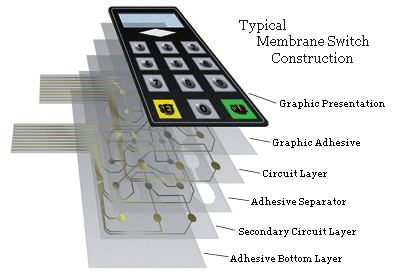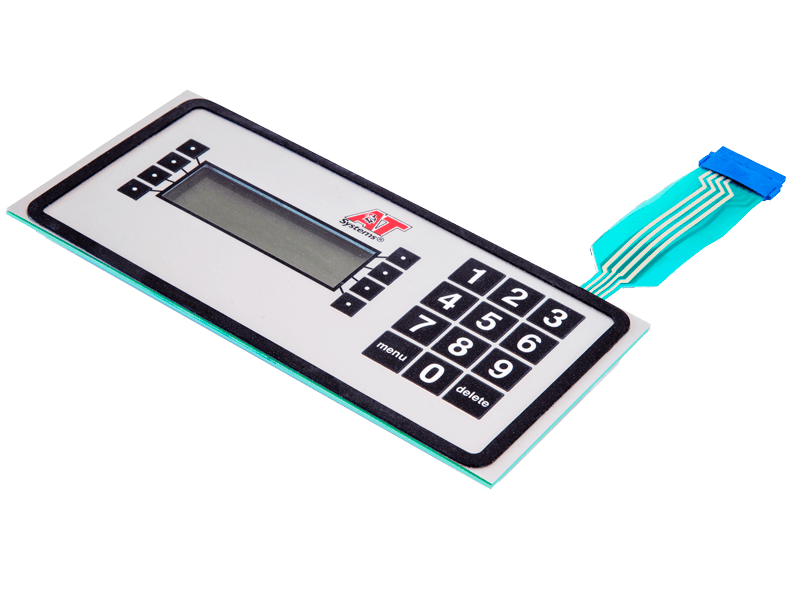Choosing a dependable membrane switch manufacturer is crucial for high-performance electronic interfaces.
Choosing a dependable membrane switch manufacturer is crucial for high-performance electronic interfaces.
Blog Article
All About Membrane Layer Switch: Recognizing Its Layout and Performance
When you think regarding the control interfaces in modern-day tools, membrane switches commonly come to mind. Allow's explore what sets membrane switches apart from other control systems.
What Are Membrane Layer Buttons?

Membrane buttons can likewise be tailored regarding shape, size, and graphics, allowing manufacturers to create special interfaces tailored to specific products. Generally, membrane layer buttons play a significant duty in enhancing customer experience throughout a vast variety of applications.
How Membrane Layer Switches Over Job
When you push a trick on a membrane layer switch, it triggers a simple yet effective device. membrane switch manufacturer. The top layer, usually made of flexible material, presses down onto a conductive layer beneath it.
You'll see that the tactile responses differs based upon the switch design, offering either a soft click or a more obvious action. As soon as you launch the key, the membrane layer go back to its original placement, resuming the circuit and quiting the signal. This procedure takes place practically immediately, guaranteeing a receptive customer experience.
Membrane buttons are prominent because of their resilience and resistance to dust and dampness, making them excellent for numerous applications, from family home appliances to medical tools. Comprehending this procedure helps you appreciate their widespread usage.
Key Elements of Membrane Switches
Understanding the key elements of membrane buttons is fundamental for understanding their functionality and layout. At the core, you'll find the graphic overlay, which supplies the visual user interface for users. Under that, there's a spacer layer that divides the circuit layers, guaranteeing that they don't make contact till pressed. The circuit layer is where the magic takes place; it is composed of conductive traces that complete the circuit when you push the switch. Another vital element is the adhesive support, enabling the switch to stick to surface areas safely. Ultimately, the safety layer guards versus environmental variables and wear, expanding the button's life expectancy. Each part plays a considerable duty in ensuring dependable performance and customer interaction. By comprehending these elements, you'll get understanding right into just how membrane changes operate and their value in different applications.
Products Made Use Of in Membrane Switch Layout
The performance and toughness of membrane switches over heavily rely on the products utilized in their design. You typically encounter polyester and polycarbonate as primary substratums as a result of their superb strength and flexibility. These products withstand scratches and chemicals, making them optimal for requiring settings.
The conductive layers typically make use of silver or carbon, selected for their integrity and conductivity. membrane switch manufacturer. Silver gives remarkable performance, while carbon is an economical alternative. For the overlay, you might take into consideration a matte or glossy coating, depending upon your aesthetic needs and customer experience
Make certain to select adhesives that withstand ecological factors like temperature level and moisture. Choosing the best products will certainly assure your membrane button stands the examination of time.
Design Factors To Consider for Membrane Switches
While designing membrane layer switches, it's important to take into account various aspects that influence their functionality and customer experience. Beginning by focusing on the layout and switch dimension; make specific they're user-friendly and simple to browse.
Do not neglect the graphic layout; clear labeling and shade comparison are substantial for exposure. Verify your design accommodates ecological elements, like wetness or temperature level variants, which can impact efficiency. Lastly, remember the value of testing models with actual customers to gather feedback and make necessary changes. This iterative procedure assists you refine the design, validating it fulfills both functional and aesthetic needs successfully. By carefully taking into consideration these aspects, you'll create a membrane button that improves usability and fulfillment.
Applications of Membrane Layer Switches
Membrane layer buttons are versatile elements discovered in different applications, from commercial tools to consumer electronics. You'll see their influence in makers that require sturdy user interfaces and in gadgets that benefit from smooth styles. Comprehending these applications aids you value the functionality check these guys out and usefulness of membrane buttons in everyday innovation.
Industrial Tools Use
When you're looking to enhance the functionality of industrial equipment, membrane layer buttons use a dependable remedy that integrates durability with easy to use layout. These switches are best for extreme atmospheres, providing resistance to dirt, dampness, and chemicals. Embrace membrane switches to enhance your procedures and boost total performance.
Consumer Electronic Devices Assimilation
In the domain of customer electronic devices, membrane switches play a necessary function in improving customer interaction and gadget capability. Membrane layer buttons also assure toughness and resistance to dirt and wetness, prolonging the lifespan of your electronics. By picking membrane switches, you enhance not just the functionality however also the design of your gadgets, making everyday communications smooth and delightful.
Benefits and Drawbacks of Membrane Buttons
While membrane switches provide a variety of benefits, they also feature some downsides that you should think about. One considerable benefit is their portable design, making them optimal for space-constrained applications. They're also cost-effective, giving a long lasting solution with a reduced manufacturing price. In addition, their smooth surface area is very easy to clean, improving hygiene in environments like hospitals.

Nevertheless, there are downsides. Membrane layer switches can have a much shorter life expectancy contrasted to mechanical buttons, especially under hefty use. They can additionally be much less tactile, which might influence user feedback during procedure. In addition, if damaged, repairing them can be challenging and often needs full substitute. Ultimately, their sensitivity to severe temperature levels and ecological conditions may restrict their effectiveness in specific settings. Balancing these advantages and disadvantages will certainly help you establish if membrane buttons are the right fit for your job.
Often Asked Inquiries
How Lengthy Do Membrane Layer Switches Over Generally Last?
Membrane layer changes usually last between 5 to ten years, depending upon usage and environmental conditions. You'll wish to evaluate elements like wear, exposure to read the full info here wetness, and temperature level variations to assess their durability successfully.
Can Membrane Layer Changes Be Customized for Particular Layouts?
Yes, you can tailor membrane switches to fit certain layouts (membrane switch manufacturer). You'll have the freedom to pick colors, forms, and designs that match your job's requirements, guaranteeing they mix effortlessly with your overall visual
What Is the Expense Range for Membrane Switch Over Production?
The price range for membrane button manufacturing usually falls between $1 and $10 per device, depending on variables like style intricacy, quantity, and materials. You can obtain quotes from producers to discover the most effective alternative.

Are Membrane Layer Changes Waterproof or Immune?
Membrane switches can be developed to be waterproof or resistant, relying on products utilized and building and construction methods. If you need them for damp settings, assure try here you specify those demands during the style procedure.
Just How Do Membrane Switches Over Contrast to Conventional Buttons?
Membrane buttons are normally thinner and extra versatile than traditional buttons, providing a sleek style. They're typically simpler to clean up and incorporate, yet may not give the tactile comments you're used to with mechanical choices.
Verdict

Report this page